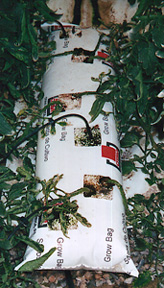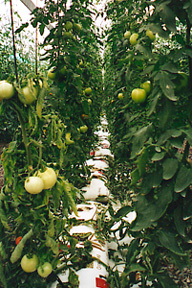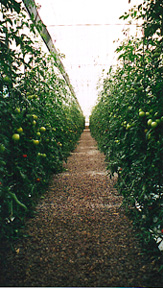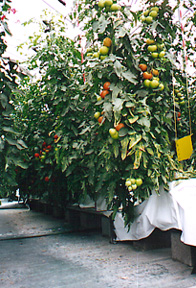
| 100% Perlite Media | PERLITE |
Almeria, Spain A Hydroponic Miracle |
PLANT GUIDE |
| The
Schundler Company 10 Central Street Nahant, MA 01908 732-287-2244 |
HYDROPONIC MIRACLE STORY
in Almeria, Spain

|
By Bruce Schundler
Based on a speech givento
In many parts of the world, but especially in the province of Almeria, Spain, hydroponic growing methods have changed the way farmers operate. And in the process, Almeria has been transformed from the poorest province of Spain into one of the ten most affluent!
Growers around the world are trying to grow more fruits and vegetables with less water and less land. And in Almeria, Spain perlite hydroponic systems seem to be helping them do this!
What makes these numbers particularly interesting is that almost 8 % of all vegetable greenhouses in Spain are now using hydroponic methods, and approximately 54% of Spain's entire hydroponic industry is in Almeria!
When growers and the government first tried to develop this greenhouse industry in the 1980's, a special "system" using sand, manure, clay, and top soil was used. The problem with this "Enarenado system" was that too much water was required and the soil eventually suffered from soil toxicity. Later more sophisticated rock-wool hydroponic systems were introduced in the 1990's, but currently the most popular media is perlite, and it is the media which is growing the most.
There are different growing systems or methods being used in Almeria, but perlite seems to be the most popular. Based on current estimates the different systems break down into the following percentages:
Perlite offers far better control over water usage and makes what water is used more available to the plants. Many growers also find perlite far more "forgiving" than other medias---if a little too much water is used or not enough, the plants do not suffer. It also has posed far fewer disposal problems, and has potential for use in retail potting soils and landscaping after being used for greenhouse production.
This trend towards using perlite hydroponic systems in bags or containers is growing throughout the world. Whether driven by water restrictions or availability (as in Israel and the Mediterranean countries), or by land use limitations (as in Holland and most of Europe), or by climatic considerations (like growing in space or in Scotland year-round), or by the banning of popular field pesticides (like methyl bromide's ban in the U.S.), the use of perlite in commercial hydroponic growing is increasing, it is answering needs around the world, and it has offered a very environmentally safe and friendly way to produce more produce with less water.
April 2004 Update
I contacted Manuel to see if anything has changed since I wrote this article. He wrote back (in broken English which I have corrected a little:)
The proportion of farmers using perlite has increased and now the percentage of growers using perlite as substrate is estimated to be around 65%!
And now there is a clear tendency in hydroponics in Spain to go to perlite instead rockwool.
There are a number of obvious advantages of perite over other media. The advantages of perlite over rock wool seem to be many: duration, the maintainence of the structures, buffer capacity, volumes per unit, performance in time, etc. All these advantages are slowly creating more and more market share for perlite---not only among new farmers going to hydroponics but also among all those that have lots of experience with rockwool. Most of the growers are looking for more security, and this is provided by perlite.
As a result, the proportion of farmers using perlite has increased and now the percentage of growers using perlite as substrate is estimated to be around 65%!
For more information, feel free to contact Manuel Lucas
For more information about these and the many uses of perlite in
hydroponic growing, The Schundler Company
The Perlite Institute on May 21, 2000
by Manuel Lucas--Gen'l Manager of Otavi Iberica
see also www.otavi.es
In Almeria, a beautiful semi-arid area along the Mediterranean, greenhouses currently cover over 30,000 hectares (more than 74,000 acres) of land from the sea to the mountains. Over 2,700,000 metric tons of produce are being grown in the region including lettuce, , cucumbers, watermelons, beans, squash, cucumbers, peppers, and tomatoes.

Perlite 36.4 % Sand 31.4 % Rockwool 22.6 % Picon 5.1 % CocoPeat 4.0 % Others (NGS) 0.5 %
In this particular greenhouse, each Perlite Grow Bag had six plants. Three would be suspended in one direction, and three in the opposite direction.


Between each row of Perlite Grow Bags, an aisle allows workers to work with the crops and harvest them.

(Picture at left) Research is currently underway to test long, reusable containers of perlite (hidden under the "draped" plastic covering the containers). This system would recycled unneeded water and nutrients, and reduce the amount of labor involved in changing the perlite "beds" when several crops have been grown.
General Manager of Otavi Iberica:
maluc@larural.es
or go to the Otavi website at www.otavi.es
contact your local extension service, The Perlite
Institute (www.perlite.org)
10 Central Street
Nahant, MA 01908
(ph)732-287-2244
www.schundler.com
info@schundler.com
Back to Horticultural Main Page